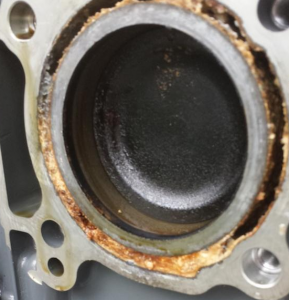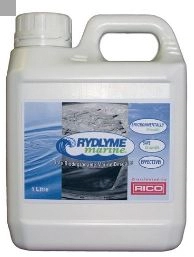
If you have a raw-water cooled marine diesel engine such as a Yanmar or a BUKH, then you will suffer from the same problem that many petrol outboard owners have. You’ll recall from your school days that when acids and alkalies are mixed, they produce a salt and water. In chemistry, a salt is a solid chemical compound consisting of cations (positively charged ions) and anions (negatively charged ions). Though solid, salts are readily dissolved in water.
Diesel Chemistry School: Click to learn more about Solubility of Salts
Seawater has a combination of salts dissolved in it – primarily, but not just, sodium chloride or table salt. On average, seawater in most parts of the world has a salinity of approximately 3.5%. This means that for every 1 litre of seawater there are 35 grams of salts dissolved in it. When a salt dissolves in water, it separates into its constituent ions – thereby allowing it to conduct electricity. The main ions present in seawater are…
- Cl⁻ (55%)
- Na⁺ (30.6%)
- SO4 ²⁻ (7.7%)
- Mg²⁺ (3.7%)
- Ca²⁺ (1.2%)
- K⁺ (1.1%)
- Others (0.7%)
As the cooling water in your engine heats up, these ionic salts can begin to precipitate back out of the water. One of the first salts to precipitate back out of seawater is CaCO3, or calcium carbonate. You might know as limestone. Clearly, limestone clogging up the channels of your engine will get in the way of further cooling. Thus, scaling can become an increasing problem. It’s good practice to clean out the cooling channels regularly. Thankfully, you don’t need to remove the cylinder head to do so.
It’s worth noting here; the thermostat on direct cooled engines opens at a lower temperature than on equivalent fresh water cooled engines to combat this problem of precipitation. Many engines are available as fresh-water cooled as an option. It is vital that you never use a fresh-water thermostat on a raw-water coolant installation.
Using Central Heating Descaler in your Marine Diesel
NOTE: It has been reported that engine manufacturers and distributors have warned owners to not descale your engines using the following technique. They cite fears of chemical cleaners deteriorating gaskets and seals. That said, many owners find it a satisfactory way to maintain clean coolant channels in their engines. As ever, our guides are offered only as advice and you should always refer to your engine’s service manual for the final word.
Many owners tell us that they use a descaler product designed for home central heating systems, Fernox [Check current price on Amazon.com], to descale their marine diesel engines. Others use Rydlyme [Check current price on Amazon.com] [see product pdf]. They begin by arranging a bucket in the cockpit with a feed line to the engine raw water pump and a second bucket under the exhaust outlet to collect the waste coolant. You also need a 12v in-line pump from the second bucket to recirculate the water back to the bucket in the cockpit. If your pump doesn’t have a built in float switch, keep an eye on it so that it doesn’t run dry.
With the boat in the water, they run the engine under load to heat it up – you need the thermostat to be open and coolant to be circulating the head.

Next, turn off the through-hull stopcock and disconnect the coolant input pipe. Run a pipe to this from the bucket in the cockpit and flush the engine with fresh water. Next, place the second bucket below the exhaust to catch the coolant being expelled. Hook up your inline pump to recirculate the spent coolant back to the first pump.
Now add the Fernox to the cockpit bucket and give it about an 90 minutes to do its job. The recirculating coolant with the descaler should gradually absorb a lot of sludge from the cooling jacket in your engine.
Shut the engine down and allow to sit for ½ to 1 hour then flush with fresh, clean water. After flushing with fresh water, remove the anode and have a look inside the block. You should see that the inside is clean. You can also observe the water jacket by removing the thermostat and stat housing.

Descaling your Engine with alternative liquids such as Vinegar or Hydrochloric acid
Some folk like the idea of flushing their engines with a mild (or not so mild) acid. Options range from Vinegar to Hydrochloric (Muriatic) acid. Others are not so sure. Acid shouldn’t have any negative effect on cast iron but some modern engine have other metals in the cooling water flow. Remember this system runs from your water pump to your exhaust. While acid is great at dissolving calcium carbonate, you’d want to be pretty sure that it won’t damage any other part of your engine. If this path is for you, proceed with extreme caution and certainly never leave the cleaning product or acid in your engine for a prolonged period of time. Thoroughly flush the engine with sea-water after you finish the job.

